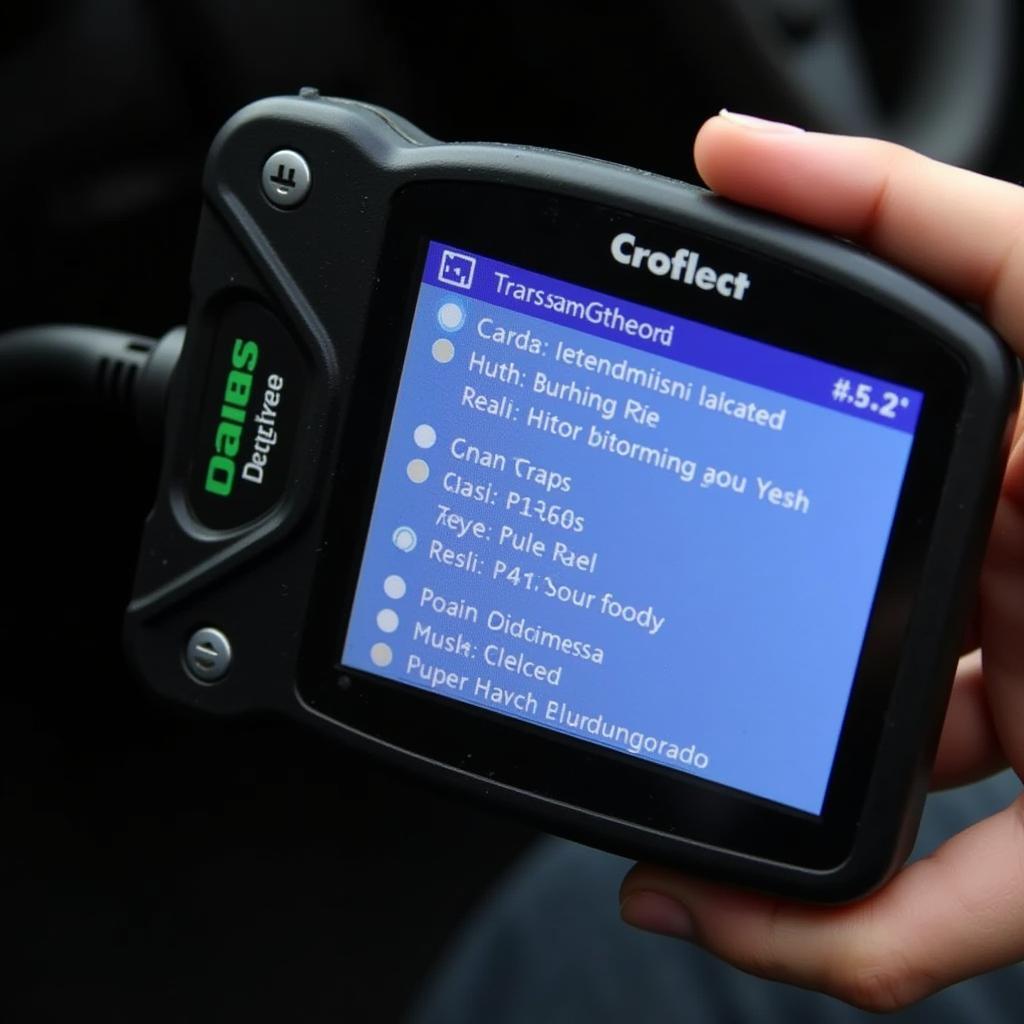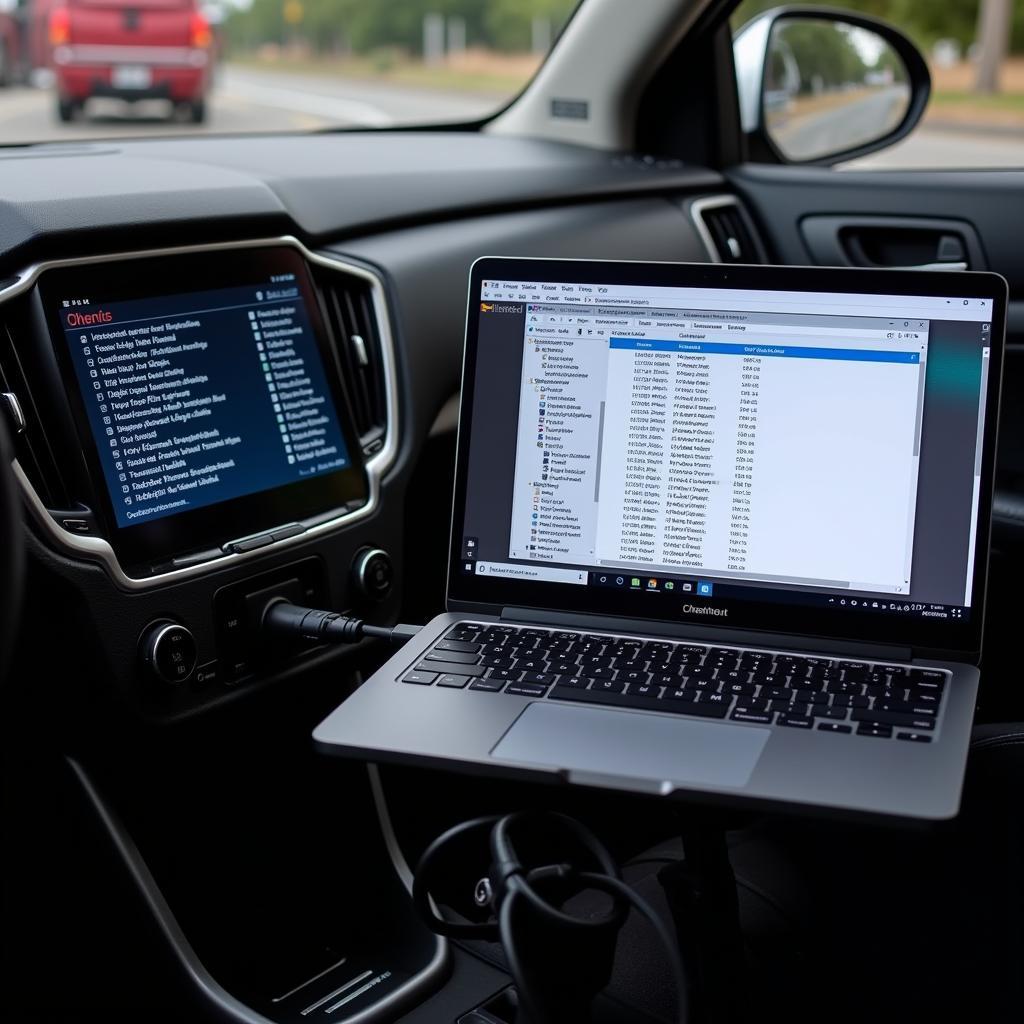A scan tool, also known as an OBD2 scanner, is an essential tool for any car owner or mechanic. It allows you to communicate with your car’s computer, read and clear diagnostic trouble codes (DTCs), and monitor live data streams. One of the most common uses for a scan tool is to diagnose transmission problems.
When your car’s transmission isn’t working properly, it can be a frustrating and often expensive problem to fix. In the past, diagnosing transmission problems was a time-consuming and labor-intensive process. However, with the advent of modern scan tools, it is now easier than ever to pinpoint the source of the problem. By understanding how to interpret Scan Tool Transmission Codes, you can save yourself a lot of time and money in the long run.
 Scan Tool Displaying Transmission Codes
Scan Tool Displaying Transmission Codes
What are Scan Tool Transmission Codes?
Your car’s transmission control module (TCM) constantly monitors the performance of the transmission. If it detects a problem, it will store a diagnostic trouble code in its memory. These codes can range from minor issues, such as a loose sensor, to major problems, such as a failing transmission solenoid. Scan tool transmission codes are alphanumeric codes that each correspond to a specific issue within the transmission system.
Why are Scan Tool Transmission Codes Important?
Scan tool transmission codes are essential because they provide valuable insight into the health and performance of your vehicle’s transmission. Understanding these codes can help you:
- Identify the root cause of transmission problems: Instead of guessing about the issue, you can use codes to pinpoint the specific area of concern.
- Save time and money on repairs: By accurately diagnosing the problem, you avoid unnecessary repairs and replacements.
- Make informed decisions about your vehicle: With a clear understanding of the issue, you can decide whether to repair or replace the transmission.
Common Scan Tool Transmission Codes
While there are hundreds of potential transmission codes, some are more common than others. Here are a few examples:
- P0700: Transmission Control System Malfunction
- P0705: Transmission Range Sensor Circuit Malfunction (PRNDL Input)
- P0715: Input/Turbine Speed Sensor Circuit Malfunction
- P0729: Gear 6 Incorrect Ratio
- P0730: Incorrect Gear Ratio
- P0740 – P0743: Torque Converter Clutch Circuit Malfunction
- P0750 – P0763: Shift Solenoid A, B, C, D, E Electrical
How to Use a Scan Tool to Read Transmission Codes
Using a scan tool to read transmission codes is a straightforward process:
- Locate your car’s OBD2 port. This port is typically located under the dashboard on the driver’s side.
- Plug the scan tool into the OBD2 port.
- Turn on the ignition but don’t start the engine.
- Follow the on-screen prompts. Most scan tools will have a menu option for reading or diagnosing trouble codes.
What to Do After Reading Transmission Codes
Once you have read the transmission codes, it’s important to:
- Write down all of the codes.
- Research the codes. You can find information about specific transmission codes online or in a repair manual.
- Diagnose the problem. This may involve checking the transmission fluid level, inspecting the wiring and connectors, or testing the sensors and solenoids.
- Repair the problem. In some cases, you may be able to repair the problem yourself. However, if the problem is complex or you are not comfortable working on your own car, you should take it to a qualified mechanic.
Expert Insight: “Don’t panic if you see a transmission code. Not all transmission codes indicate a serious problem. However, it’s important to address the issue sooner rather than later. Ignoring transmission problems can lead to more extensive and expensive damage down the road,” says John Smith, a certified automotive technician with over 20 years of experience.
Tips for Troubleshooting Transmission Codes
Here are some additional tips for troubleshooting transmission codes:
- Check the transmission fluid. Low or dirty transmission fluid can cause a variety of problems.
- Inspect the wiring and connectors. Loose or damaged wiring can also cause transmission problems.
- Test the sensors and solenoids. A faulty sensor or solenoid can cause the transmission to shift erratically or not at all.
- Use a professional scan tool. Professional scan tools offer more features and capabilities than basic code readers.
Can I Drive My Car with a Transmission Code?
Whether or not you can drive your car with a transmission code depends on the severity of the problem.
- If the transmission is slipping or shifting erratically, it is not safe to drive your car.
- If the check engine light is flashing, it indicates a serious problem, and you should not drive your car.
- If the check engine light is on but the transmission seems to be working properly, you may be able to drive your car for a short distance. However, it is important to get the problem diagnosed and repaired as soon as possible.
Expert Insight: “If you’re experiencing any unusual noises, vibrations, or warning lights related to your transmission, it’s always best to err on the side of caution and consult with a qualified mechanic,” says Jane Doe, a certified mechanic and automotive instructor.
Conclusion
Scan tool transmission codes are invaluable for understanding and troubleshooting issues within your vehicle’s transmission system. By familiarizing yourself with these codes and utilizing a scan tool effectively, you can take control of your car’s maintenance and make informed decisions about repairs. Remember to address transmission problems promptly to prevent further damage and ensure optimal vehicle performance.
For assistance with diagnosing and addressing transmission codes, contact ScanToolUS at +1 (641) 206-8880 or visit our office at 1615 S Laramie Ave, Cicero, IL 60804, USA.

